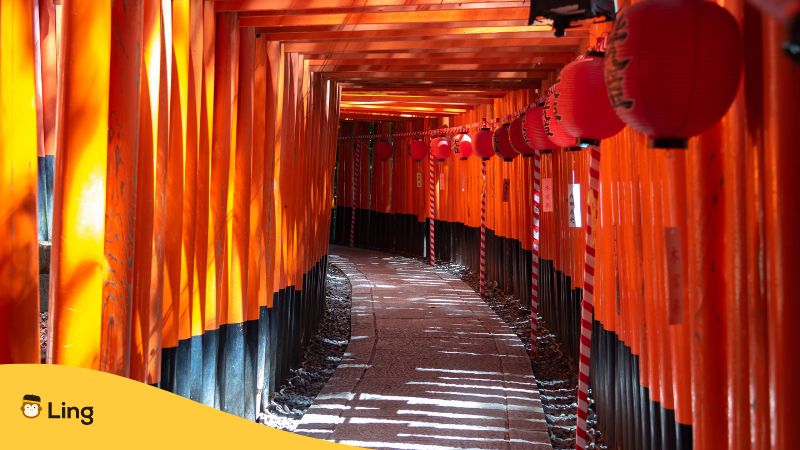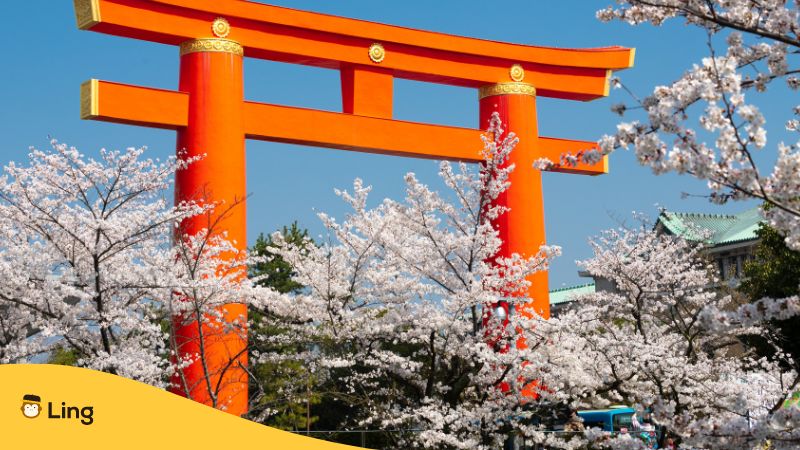When you think of Japanese torii gates (鳥居), the one at the Hakone Shrine or 箱根神社 (Hakone jinja) near Mount Fuji or Fujisan (富士山) comes to mind. After all, it’s one of the most iconic torii gates in Japan. But as beautiful as it is, you’ve probably seen photos or videos of long lines of people queuing up just to get the perfect shot with it.
Anyone who visits Japan would want a photo with torii gates, be it the one at Hakone or any other torii gate, because they’re just so majestic and so distinctively Japanese. In fact, many people say that your trip to Japan isn’t complete without one.
But there’s more than just beauty to these stunning torii gates. In this article, I’ll be telling you all there is to know about Japanese torii gates, as well as teaching you some Japanese phrases related to them. That way, you’ll appreciate the torii gates beyond just their beauty.

What Is A Japanese Torii Gate?
Before we begin, let’s break down what torii gate (鳥居) in Japanese means. The word 鳥 (tori) means “bird” in Japanese, while the word “居” means “to be” or “to exist” in Japanese. It could also mean “residence” or “dwelling”.
When the characters 鳥居 (torii) are combined, they don’t literally mean “existing bird” or “bird residence” as you might expect. Instead, they refer to, you got it, the traditional Japanese gate typically found at the entrance to Shinto shrines or 神社 (jinja).
Now, you may be wondering, how do you tell apart a torii gate from a regular gate? You’ll be glad to know that it’s not hard at all! Aside from their striking painted red color, torii gates consist of two pillars connected by two horizontal beams on the top.
This distinctive feature resembles a bird in flight, which is what the 鳥 (tori) in its name strives to encapsulate! And since they’re often placed at entrances, the word 居 (i) signifies the function of torii gates as a gateway to a sacred space.
Humans aren’t the only beings that pass through torii gates. Symbolically, passing through a torii gate also marks the symbolic gateway from the mundane to the sacred! People also believe that Gods or 神 (kami) travel through them as the torii gates serve as a welcome to the human world.
So if you’re scratching your head, wondering how you can tell Shinto shrines apart from other kinds of shrines, simply keep an eye out for torii gates! And if you’re using a map, you can easily spot a small torii gate icon that represents them to locate them.

History Of Japanese Torii Gate
There isn’t a fixed answer to this because no one knows for sure how torii gates came to be. As such, there are various theories that surround this topic. One of them is that the name “torii” derives from “tori iru” or 鳥居る (tori iru), which means “bird perch” in Japanese.
If you’re imaginative enough, you can probably picture a giant bird perching atop a torii gate. After all, it’s true that they kind of look like a bird perch. So this theory may or may not be true, but since it’s not confirmed, who knows for sure?!
And since the use of torii gates is widespread in Asia, another theory suggests that they may or may not be influenced by similar structures from countries like India, China, Thailand, and Korea. As such, some think that it may be an imported tradition that adapted over time to a distinctively Japanese style.
Over time, torii gates have changed in how they look and what they mean, becoming important parts of Shinto shrines all over Japan. Whether you find them in the form of simple wooden gates or elaborate stone and metal ones, each gate embodies the essence of Japanese culture in its own way.

Iconic Torii Gates In Japan
Here are some of the most iconic torii gates you should definitely visit if you can the chance to.
Fushimi Inari Shrine, Kyoto
Nestled in southern Kyoto, Fushimi Inari Shrine or 伏見稲荷大社 (Fushimi Inari Taisha) is a Shinto shrine you don’t want to miss!
What makes it so special, you may ask? Well, picture this: Hundreds of vivid purple torii gates winding via trails in the back of the principal homes. These trails lead you into the lush woodland of Mount Inari, which towers at 233 meters and is part of the shrine.
But wait, there may be more! Fushimi Inari Shrine isn’t just any shrine; it’s dedicated to Inari (稲荷), the Shinto god of rice and prosperity. And since foxes are said to be Inari’s little helpers, you definitely won’t miss the fox statues scattered around the shrine grounds as you wander around.
How to get there: Take the JR Nara Line from Kyoto Station. Inari Station is the second stop, so you’ll reach there in no time! It only takes about 5 minutes to get there from Kyoto. You can also buy a JR pass if you want to easily access the train lines.
Heian Shrine, Kyoto
Another shrine in Kyoto you wouldn’t want to miss is Heian Shrine or 平安神宮 (Heian Jingū). It may not be as old as other shrines, but it has a charming history.
Built in 1895 to commemorate Kyoto’s 1100th anniversary as the capital, it honors the spirits of Emperor Kammu and Emperor Komei, who once ruled from this metropolis.
As you approach the shrine, you’ll be greeted by means of a huge torii gate, painted in colorful vermilion. This gate is considered one of the biggest in Japan and sets the tone for the grandeur inside.
The shrine’s spacious grounds also consist of a courtyard on the middle, surrounded by way of homes which are a partial reproduction of the original Imperial Palace from the Heian Period.
That’s not all! Inside the shrine, you’ll find a couple of museums to explore, where you can fully immerse yourself in the history of Kyoto and its former imperial glory. Sounds grand, doesn’t it?
How to get there: Take the city bus from Kyoto Station. These buses are specifically catered towards tourists as they stop at many major attractions, allowing you to easily hop on and off whenever you like.
More Torii Gates
Of course, the torii gates at Fushimi Inari Shrine and Heian Shrine in Kyoto aren’t the only ones that you can check out. Here’s a list of other famous shrines with famous torii gates in Japan:
- Meiji Shrine, Tokyo Prefecture
- Hakone Shrine, Lake Ashi, Kanagawa Prefecture
- Itsukushima Shrine, Miyajima, Hiroshima Prefecture
- Shitenno-Ji Temple, Osaka Prefecture
- Kinpusenji Temple, Nara Prefecture
- Arakura Sengen Shrine, Yamanashi Prefecture
- Motonosumi Shrine, Yamaguchi Prefecture
- Kumano Hongu Taisha, Wakayama Prefecture
Also, don’t forget to give a little bow as you walk through a torii gate. It shows respect for the sacred space and the kami believed to be there. You may also cleanse yourself at the nearby water basin by washing your hands and mouth.
Remember, torii gates aren’t just pretty; they’re full of spiritual meaning and history. So, next time you walk through one, take a moment to enjoy the tradition and say a silent thank you for the journey ahead!
Easy Japanese Phrases For Japanese Torii Gates
Here are some easy Japanese phrases related to Japanese torii gates.
Ready To See Japanese Torii Gates?
So you see, torii gates are a really important part of Japanese shrines and the Shinto religion. You can tell apart shinto shrines from others as soon as you see them, so that’s just how distinct they are! That’s why you should totally see them for yourself if you get the chance.
And while you’re at it, you should download the Ling app and learn Japanese, just in case you have any questions! By learning some Japanese, you’ll definitely be able to communicate with Japanese people and discuss torii gates and other topics with them. It doesn’t matter whether you’re striving to be just a beginner or an advanced speaker as the Ling app has everything you need, so try it today!



































































